Don't wanna be here? Send us removal request.
Text
The Pros and Cons of Working with Acrylic Paint
Acrylic paint was first developed in the 1950s as house paint and was made commercially available in the 1960s as artist-grade paint. And since then, it has become the primary art material for many contemporary artists.
Compared to oil paint and watercolour, acrylic paint is a recent discovery in art. Its versatile nature, vibrancy and stability have overtaken the art world. As more artists take advantage of the broader perspective of acrylic paint, more acrylic paint products hit the market.
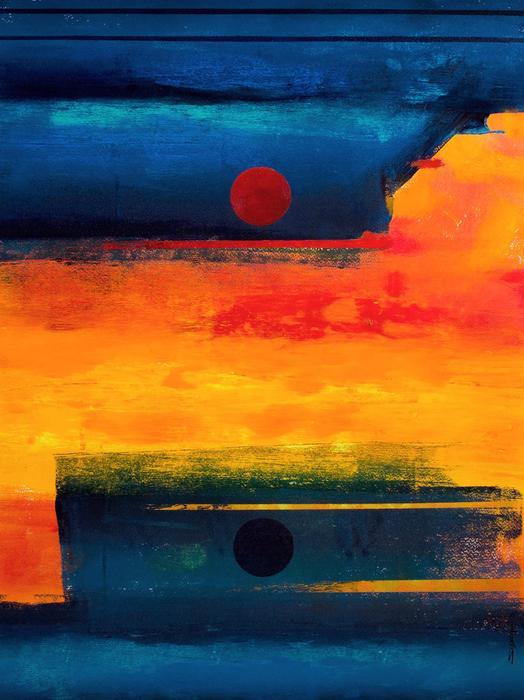
Want to learn more about acrylic paint? Here we will tell what it is, its pros and cons.
WHAT IS ACRYLIC PAINT?
Acrylic paint is paint made from pigments suspended in an acrylic emulsion. It is water soluble and fast drying and becomes water-resistant after drying.
Acrylic paint is highly versatile. Depending on how much the paint has been diluted with water, or modified with acrylic gels, mediums, or pastes, a finished acrylic painting may resemble a watercolour, a gouache, or an oil painting. It may also have unique characteristics that are not obtainable with other media.
WHAT MAKES ACRYLIC PAINT DIFFERENT?
Previously, artists used to mix their paints to get the colours and textures they wanted. They could control the ingredients, like fillers, in their paints. However, it could be more practical to mix it by hand with acrylic paint. That's because it dries quickly and has other technical issues. Instead, artists buy ready-to-use acrylic paint, which they can modify using acrylic mediums or water.
Acrylic mediums offer more options compared to watercolour and oil paints. Acrylics can stick to many different surfaces, and mediums can be used to change how they bind to those surfaces. Acrylics can be used on paper, canvas, and various materials like hobby models (trains, cars, houses).
TRADITIONAL VS MODERN ACRYLIC PAINT
Even though acrylic paint is relatively new to the art world, there are still paints referred to as 'traditional' acrylic paint and 'modern' acrylic paint. Traditional acrylic paints are fast-drying paints that have been around for the past five decades and are made from brands such as Liquitex, Winsor & Newton, Golden and Grumbacher. Modern acrylic paints do not dry as quickly and can be reactivated after drying, and are made from brands such as Dirums and Chroma.
PROS AND CONS OF TRADITIONAL ACRYLIC PAINT
Toxicity level
Advantage: Acrylic paints are water-based, meaning they can be thinned with water (no toxic spirits are needed). In addition, wet paint can be cleaned using only soap and water.
Disadvantages: The pigments in acrylic paint can contain toxins, as can those in some oil paints. Additional toxins can be found in acrylics that use 'retardants' to slow drying time.
Drying time
Advantage: Traditional acrylic paints dry fast, so there's no need to wait between painting sessions for layers to dry. The paintings are dry enough to be shipped safely within a day or two.
Disadvantages: Because acrylic paints dry quickly, they cannot be mixed easily to create the 'wet in wet' technique popular with oil paints. For this reason, a finished acrylic painting may look more tacky than a finished oil painting.
Reactivation
Benefits: Unlike watercolours (another water-based paint), once traditional acrylics dry, they are mounted on a support for a longer shelf life. This makes it easier to paint new layers on top of the previous ones.
Disadvantage: It cannot be removed or changed once the paint is dry.
DURABILITY
Benefits: Acrylic paints have proven to be more flexible than oil paints. There's no need to follow the fat over-lean rule with acrylics so they don't break.
Disadvantages: We've only had acrylic paints for about 50 years, so we can't comment on how long they'll last.
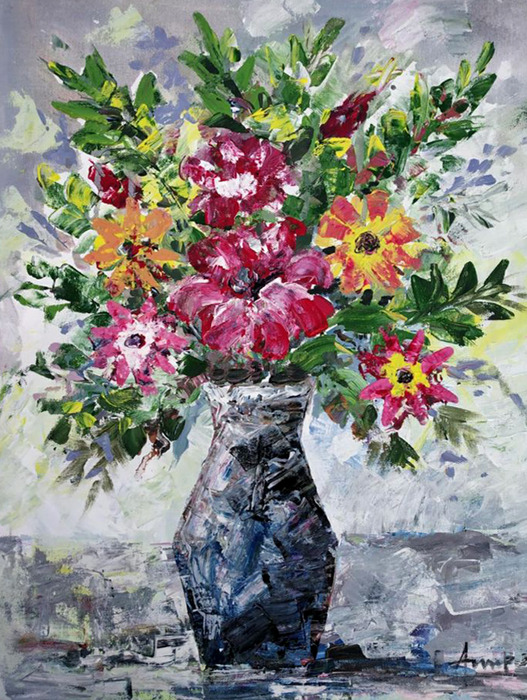
Consider the advantages and disadvantages of acrylic paint
Pros
It is versatile. You can paint on any surface that is oil and wax free. This includes canvas, wood, paper, rocks, glass, fabric, cardboard, metal and plastic. With the proper preparation, you can use acrylic paint on almost anything.
It dries quickly. With this, you can complete your project faster.
It is soluble in water. You can wash it off with your hands and brush (while they're still wet) with soap and water without needing paint thinner.
It is less toxic and much safer around children and pets.
It is more economical.
It's flexible. You can mix acrylics with many different mediums to get different textures, adhere characteristics, or change the drying time.
It is durable. As far as we know, acrylics are flexible and will not break, peel or yellow.
It's alive.
It is waterproof when dry.
Cons
It gets darker when it dries, so you won't necessarily get the exact colour you paint with.
It's also fast-drying, which means you'll have to work quickly.
Once dry, it is difficult to remove once dry with a brush, fingernail or cloth. It's best to have a water container when you paint to keep the brushes wet, so they're easier to clean. You should also wear protective clothing.
Once dry, it is difficult to remove with fingernails or clothing.
It is considered by some art galleries and collectors to be 'not as valuable' as compared to other paint mediums.
Discover a wide collection of acrylic artworks in various subjects such as nature and religious paintings at discounted prices from Dirums Collective. As an Indian-owned online company, they are committed to offering you a broad selection of arts and home decore supplies at competitive prices. Start shopping today.
Artwork, much like the decorations found in luxurious hotels, adds a special touch and attractiveness to accommodations. It fosters creativity, offers fresh perspectives, and provides a relaxing escape from daily routines.
4 notes
·
View notes
Text
Pattachitra: An Ancient Folk Art that Reflects the Ethos of India
Traditional arts are an important part of the culture, where skills and knowledge are passed down from one generation to the next. It is transmitted orally and by following in the footsteps of a cultural group.
Leaf painting is important in Oriya painting, which developed in the Jagannath temple of Puri in the 12th century. The Jagannath Temple has been the centre of art and culture in Odisha.
Puri and Raghurajpur are famous for their myths, deities and folklore associated with Pattachitra. This art flourished under the support of the Ganga kings and the Bhoi dynasty. These paintings aimed to popularise Jagannath's worship among the millions of pilgrims visiting Puri.
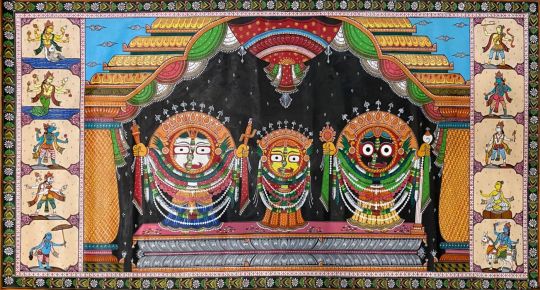
The origins of Pattachitra painting can be traced back to the 8th century AD, making it one of the earliest forms of indigenous painting. The word "Pattachitra" comes from the Sanskrit words "Patta", meaning canvas, and "Chitra", meaning painting. Thus, Pattachitra involves creating canvas paintings that depict vibrant colours, unique motifs and designs and often mythological themes.
Most of these paintings depict stories of Hindu gods and goddesses. Pattachitra art refers to the ancient frescoes found in sacred centres such as Puri, Konark and Bhubaneswar in Odisha, which date back to the 5th century BC. Fine examples of this art can be seen in and around Puri, especially in the villages of Raghurajpur and Dandsahi.
Different Styles of Pattachitra Paintings
Pata paintings come in a variety of styles, including paintings of Jagannath, the Holy Trinity, and paintings of their chariots. Pattachitra is based on Ramayana, Mahabharata, Bhagavad Gita and various Puranas and Kavyas. Pattachitras of folktales and animal-bird stories, as well as erotic pattachitras.
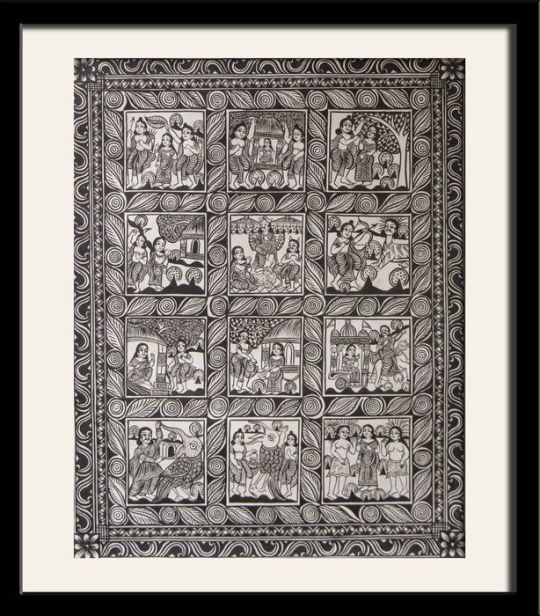
Process of Making Pattachitra Paintings
To begin with, the folk painter chooses two pieces of cloth and sticks them together using a paste made from tamarind seeds. Tamarind seeds are soaked in water for a few days till they swell and become soft. Then, they are pounded with a pestle to make a thick paste. A little water and the ingredients are added to an earthen pot, and the mixture is cooked to make a fine paste. This glue is used to bind two fabrics together, forming a bandage.
The colours used in folk artworks are made from natural elements found in India. Some examples include porcelain, soft clay or chalk, conch shell, red stone and yellow-brown ocher. For the white colour, the artists use shells found in abundance on the beaches of Orissa. Folk women make folium by placing the oiled leaves on a burning flame, which creates a black colour. Gum is added to the juice of green leaves to make the green colour. Red and yellow colours are made by grinding red and ocher stones and making their paste. The blue colour is obtained from a blue stone called Rajbarta. These colours also symbolize the essence of each character depicted in the painting. White represents "laughter" (Hasama), red represents "anger" (Raudra), and yellow represents "awe" (Adhibhuta).

In making patas paintings, traditional artists use five primary colours. These natural colours are associated with the divine colours of Jagannath, Balabhadra, Subhadra, Sihasana and Neela Chakra, recognized by Orissa's folk painters and sages. These are collectively called the Pancha Tattva, which means the five components.
Pattachitra painting requires a floral border with intricate designs and leaves, as the Chitra highlights the folklore and story. The lines are bold, crisp and sharp. In general, there is no landscape, perspective or distant view here. All events are shown adjacent to each other. The Pattachitra style combines folk and classical influences.
With time, a significant change has been observed in Pattachitra art, and painters have started painting on palm leaves and Tussar silk.
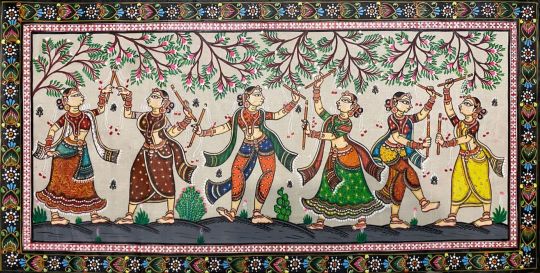
Pattachitra paintings are not limited to cloth only; Setting up palm leaves or silk. It is practised on sarees, purses, wall hangings and even showpieces. These scroll paintings are not confined to South India but spread to western parts of India and Western countries. Under the leadership of the American Friends Service Committee, an exhibition was organized at Puri Town Hall in 1953, and two shows were held in Delhi and Calcutta in 1954. Shri Nabakrishna Chowdhary, the then Chief Minister of Orissa, worked hard to revive the indigenous art form of Orissa.
1 note
·
View note
Text
Gond Art : A Folk Art Form with Beautiful Tribal Colours, Themes and Shapes
The Gond tribe originated in Madhya Pradesh, and their name comes from the word 'Kond,' which means "green mountain." While Gond art is mainly associated with Madhya Pradesh, it is also popular in Andhra Pradesh, Maharashtra, Chhattisgarh, and Odisha. The Government of India has taken steps to preserve the Gond art, aiming to support the artisans financially and inspire future generations. As a result, Gond art has gained popularity and is now showcased in international exhibitions, fetching high prices.
The Rich History of Gond Art

Gond people have been practicing painting and other art forms for more than 1400 years. They have a long tradition of making art on cave walls, dating back to the Mesolithic period. The Gonds believe that seeing beautiful images brings good luck, so they traditionally paint motifs, tattoos and images on the floors and walls of their homes. These images also serve to preserve and share historical knowledge and teachings.
Pradhan Gonds are known for their impressive skills in both art and music. In the 1980s, the director of the Bharat Bhavan Museum in Bhopal, J. Swaminathan, wanted to showcase urban and tribal art together. He sent his students to various villages in the Dindori district to find artists, and one of them was a notable painter named Jangarh Singh Shyam, who belonged to the dominant Gond community. Jangarh Singh Shyam was the first tribal artist to use canvas and paper for his artwork.
The Natural Themes of Gond Art

The Gond people believe that every element of nature, be it mountains, sky or trees, is the abode of a spirit. Hence recreating the forms of nature is done with reverence and worship of their sacred essence. These paintings serve as an example of the close connection of the Gond tribe with the spirit of nature. Gond paintings draw inspiration from the myths and legends of India. They also depict scenes from the contemporary life of the people. An elaborate narrative portrays abstract concepts involving feelings, dreams, and imaginative constructs. Since many Pradhan Gonds are accomplished musicians, their paintings often depict stories from their songs.
The most important subjects explored and depicted in Gond's paintings include birds, animals and mythological animals. Since the paintings also derive themes from the people's daily lives, the Mahua tree is an important subject. Considered the tree of life, the flowers, fruits, seeds and leaves of the Mahua tree serve many purposes for the tribe. Urban themes depict modern themes such as technology and automobiles. Folktales and local deities like Phulwari Devi, Jalharin Devi and Marahi Devi are culturally important.

The Exquisite Shapes of Gond Art
The style incorporated takes care that the lines, whether of the border or of the internal intricacies that form the subjects, immediately attract the viewer's attention. Dots and dashes accentuate the details with exquisite brilliance unique to Gond paintings. The inclusion of various geometric shapes and patterns, such as fish scales, water droplets and seed shapes, round out the expressive value of the art. A sense of motion is established through the curves and strokes of the lines, and so many critics have described it as an 'on line work.'
0 notes
Text
Gond: Tribal Art of the Heart of India
Gond art is a traditional form of painting that originated in Madhya Pradesh, India. It is mainly practiced by the Gond tribe living in that state. However, it can also be found in other states like Andhra Pradesh, Odisha, Maharashtra, and Chhattisgarh.
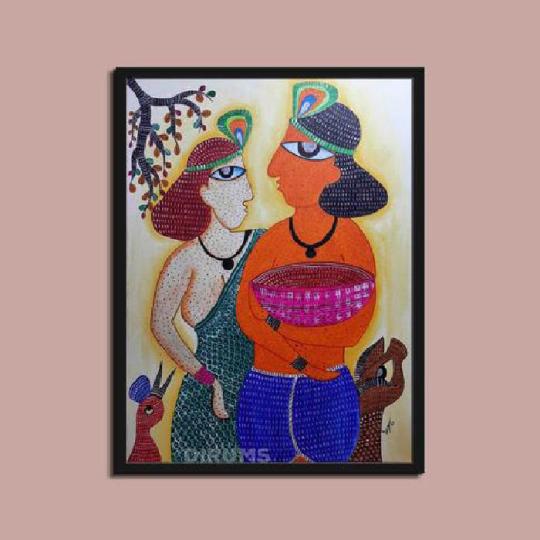
The Gonds are the largest tribal community in India, and their art is highly valued for its cultural heritage. Gond paintings showcase the tribe's lifestyle, their surroundings, and the wildlife in their area. These paintings also depict their beliefs, mythical creatures, and characters from their folklore, all of which are an essential part of their artwork. The Gond tribe believes that having good pictures around them brings good luck and positive energy. Animals play a significant role in their art, as the tribe believes that all beings are spiritual and sacred.
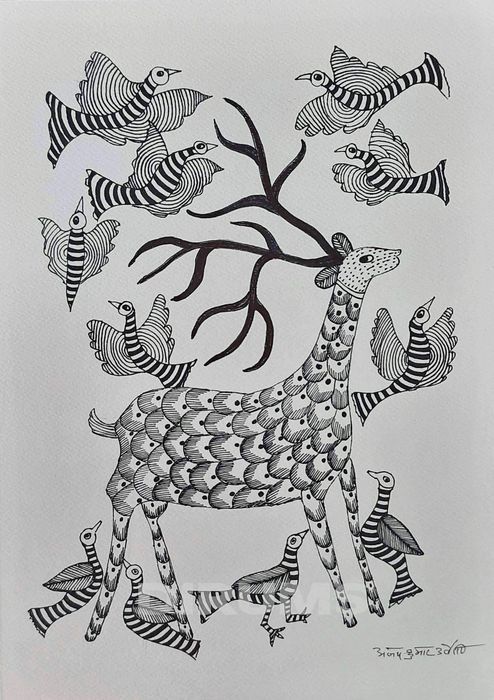
Gond paintings are filled with bright and lively colors like orange, yellow, blue, and red. They are created using carefully drawn lines and dots that bring the paintings to life. The artists use natural colors derived from sources like flowers, stones, and other materials to create these beautiful artworks.
The word “Gond” comes from the Dravidian expression kond, meaning “the green mountain.” The work of Gond artists is rooted in their folk tales and culture, and thus story-telling is a strong element of every painting.
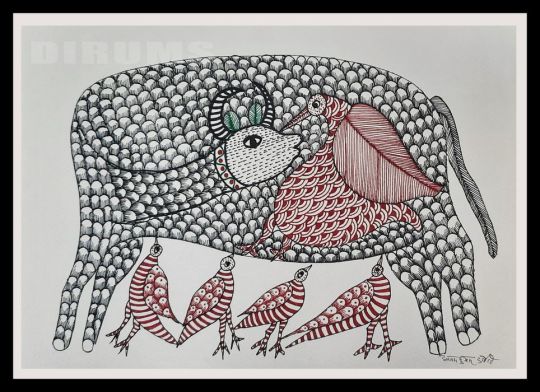
Gond art stems from the belief that a good image brings good fortune. This underlying belief has inspired the Gonds to decorate their homes and floors with traditional tattoos and motifs. Today, Gond art products such as Gond paintings on wood, painted wooden trays, and boxes have become extremely popular globally.
It is a matter of pleasure that Gond art has not escaped the eyes of art connoisseurs of the country. The Government of India is making efforts for the preservation of Gond painting. Other well-wishers went further and created Must Art Gallery – the world's first art gallery dedicated to Gond art. Unlike so many other treasures of Indian culture that have slipped through the cracks of time and are lost forever, the future of Gond art looks as vibrant and colourful as the paintings
----- END OF ARTICLE -----
#artwork#paintings#contemporary art#gondartwork#artgallery#artistsoninstagram#artistic#art on canvas#homedecor#artwork for sale
3 notes
·
View notes
Text
Gond Art: History, Elements and Stories

'Gond' comes from the Dravidian word 'kind,' which means 'green mountain.' Gond painting is a famous folk art form of the Gond tribal community of central India. It is a form of painting from the folk and tribal art of one of the largest tribes in India - the Gonds - who are mainly from Madhya Pradesh but can also be found in pockets of Andhra Pradesh, Maharashtra, Chhattisgarh and Odisha., The history of the Gond people is about 1400 years old. Mixed with a mix of mystery, patterns, colors and humor, these artworks reflect a modern psyche.
Elements of Gond Art
The untrained eye may confuse Gond art with Madhubani painting, Mithila distinct characteristics. The paintings use vibrant colors such as orange, yellow, blue and red and are made with artistically drawn lines and dots to bring them to life. Natural colors from various sources, like flowers, stones etc., are used to create these beautiful paintings.
Over the years, Gond artists have developed their own tools for working with various contemporary mediums and materials. They would first plot the points and calculate the volume of the images. These points will be connected to bring up an outer shape, which will then be filled with colors. Everything that comes to life is aesthetically transformed as they react to the immediate social situation and environment. The images are tattoos or minimalist human and animal forms which include chameleons, butterflies, elephants, cows, lions, fish, peacocks and other birds.
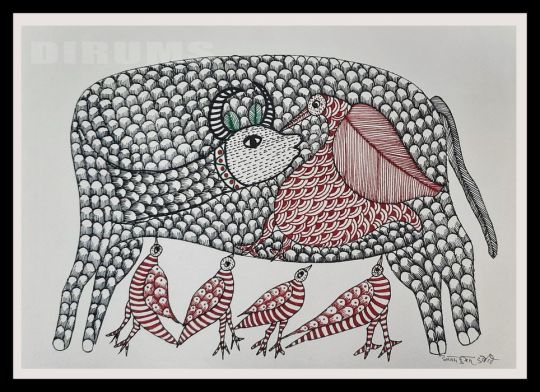
Though Gond paintings are centuries old, with time, this art form has gradually shifted from the mud walls of houses to canvas and paper. Apart from drawing inspiration from legends and myths, these paintings featured nature as their main subject. However, this painting style has other well-depicted subjects, including Hindu deities (especially Ganesha), the Tree of Life, and jungle scenes. With various motifs and design patterns, these paintings have attracted the attention of many people, including those from India, France, the UK and the US.
Stories and Symbolism in Gond Art
"Trees are of great importance in Gond art. For humans and animals alike – for animals and birds, trees are most important – to protect them from the sun in summer and rain during the monsoon season. Trees also provide nutrition and food," says artist Venkat Raman Singh Shyam.
The Ganja Mahua Tree tells the story of a Brahmin (high caste) girl and a Chamar (low caste) boy - when they fell in love, society did not accept them. So he renounced everything, went to the forest, and was later reborn as Ganja and Mahua trees. That's why it is said that Ganja and Mahua should not be consumed together because they can never be together.
Saja Tree: The Saja tree is worshiped by the Bada Dev (Elder God) and the Gond community.
Pakri tree: When new leaves bloom from this tree, the Gond community eats the greens made from these leaves, protecting them from many diseases and ailments.
Peepal Tree: The Peepal tree is where the deities (gods) reside, and thus, the Peepal tree is considered the most important.
Tamarind Tree: Tamarind tree also plays an important role for the tribal people as they use tamarind fruit for chutney and sell it for their livelihood. Many people of the Gond community set up platforms for the gods and goddesses under the trees.

Music in Gond communities
In the past, Gond artists were responsible for orally passing down the Gond kings' traditions through songs and instruments called 'Bana.'
They would invoke Lord Bada Dev on the saja tree by playing the flute and recording the genealogy of the Gond patrons in song. In return, they were given gifts of grain, clothing and perhaps even cattle or gold.
Similarities between Gond art and tribal art?
"Gond is similar to tribal art because tribals have their own stories as we do about creation, and they also make dashes and dots. Tribal art and Gond art have their connection because we are originally from the same continent of Gondwana from when there were only two continents, Gondwana and Laurasia. India and Australia came from Gondwana, and America came from Laurasia.
The performances, dances, rituals, and drinks they serve are similar to ours. Their surname is Marawi, while ours is Marawi. I spoke on the topic 'You are my brother, in you I found myself' at Monash University in Melbourne and the Queensland Art Gallery of Modern Art in Brisbane." Gond master artist Venkat Raman Singh Shyam said.
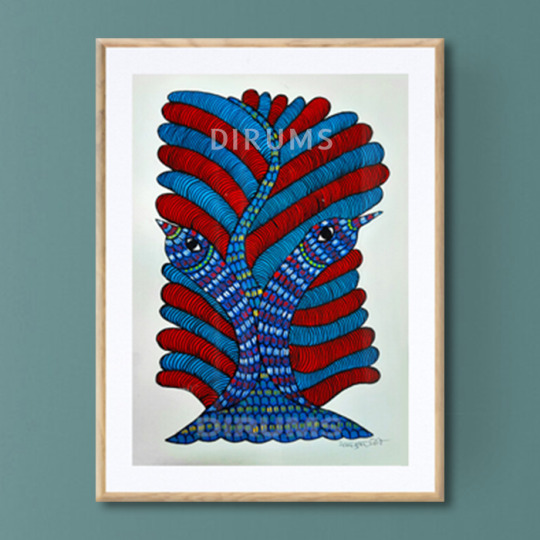
Paints are usually derived naturally from charcoal, colored clay, plant sap, clay, flowers, leaves and even cow dung. That said, due to the lack of natural dyes, Gond artists have started using poster colors and canvas to paint.
The Gond painting resembles the Aboriginal art of Australia as dots are used in both styles to create the painting. There are different types of dots in both art forms. For tribal art, the points symbolize the field and dreams, while with Gond art, the shamans believe that particles of their bodies spread out into space to connect with spirits and create other bodies. It is an ancestral, poetic vision of the atom, joining the infinitely small into the infinitely large.
1 note
·
View note